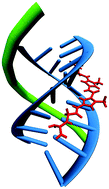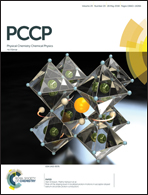DNA triplex structure, thermodynamics, and destabilisation: insight from molecular simulations†
Abstract
Molecular dynamics simulations are used to elucidate the structure and thermodynamics of DNA triplexes associated with the neurodegenerative disease Friedreich's ataxia (FRDA), as well as complexes of these triplexes with the small molecule netropsin, which is known to destabilise triplexes. The ability of molecular simulations in explicit solvent to accurately capture triplex thermodynamics is verified for the first time, with the free energy to dissociate a 15-base antiparallel purine triplex-forming oligomer (TFO) from the duplex found to be slightly higher than reported experimentally. The presence of netropsin in the minor groove destabilises the triplex as expected, reducing the dissociation free energy by approximately 50%. Netropsin binding is associated with localised narrowing of the minor groove near netropsin, an effect that has previously been under contention. This leads to localised widening of the major groove, weakening hydrogen bonds between the TFO and duplex. Consequently, destabilisation is found to be highly localised, occurring only when netropsin is bound directly opposite the TFO. The simulations also suggest that near saturation of the minor groove with ligand is required for complete triplex dissociation. A structural analysis of the DNA triplexes that can form with the FRDA-related duplex sequence indicates that the triplex with a parallel homopyrimidine TFO is likely to be more stable than the antiparallel homopurine-TFO triplex, which may have implications for disease onset and treatment.



 Please wait while we load your content...
Please wait while we load your content...